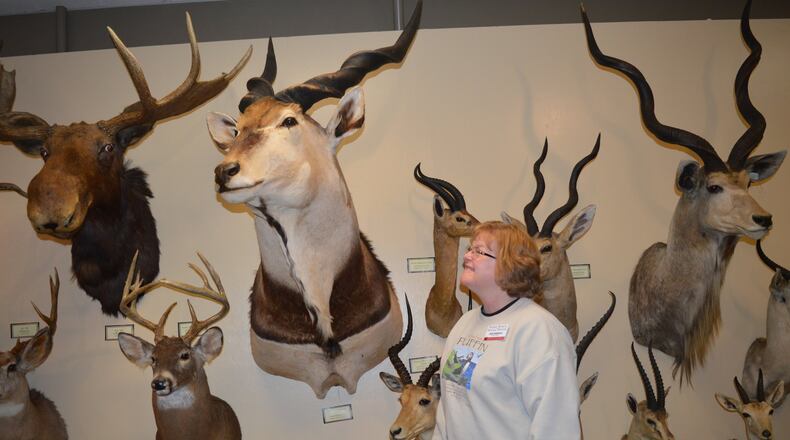Steve Sullivan arrived on campus last year as director of the Hefner Museum with dreams of making over the physical space as well as adding realistic displays to enhance the educational opportunities found there and renew its popularity.
That effort has taken a giant leap forward since his arrival with a new look, more cataloging and more learning opportunities for not only the casual visitor, but also those doing more in-depth research into the natural world.
Students in the natural sciences, of course, have long known of the Hefner Museum as some classes meet there and assignments often sent them there.
“We want to be a community resource and, frankly, the community is a resource for us,” Sullivan said. “We have a lot (of specimens) in storage, not for display but for education of students. We depend less on manuals and promote inquisitive learning.”
The museum has more than 53,000 specimens in its collection but their web site notes it is “far more than the sum of its collections. It is an archive of experiences, a repository of memories, a keeper of stories.”
Sullivan is the museum’s chief storyteller.
He excused himself from an interview and tour to ask two young women obviously looking for information if he could help them. They had been assigned to research passenger pigeons for a class on the university’s Hamilton campus and the museum had a preserved specimen of that now-extinct bird. It was not on display, however, but in an adjoining classroom.
With that specimen on the counter in front of them, he asked questions to coax speculation from them about the birds and then started telling them stories about how the birds were once so plentiful, huge swarms of them would fly over Oxford darkening the skies so much it would frighten horses.
He told them the name of Pigeon Forge, Tenn., got its name from similar fly-overs when “pigeon poop caused agricultural production to increase.”
He also told the women, sisters Brooke and Paige Sullivan (no relation to him), that raising chickens was expensive in the 1800s and people ate pigeons, not chicken.
“We ate them into oblivion,” he said.
Walking down the hallway toward the entrance of the Hefner Museum of Natural History, a regular visitor will notice one of the biggest changes immediately. Welcoming visitors from the far wall is the fierce-looking brown bear now moved from the side room to main area.
The bear has long been a popular, if menacing, staple of the museum and Sullivan said it just made sense to move it to a more prominent spot.
“It is a magnificent specimen and majestic. It was killed in approximately 1924,” he said. “Its pose is threatening but was probably never in that pose in its lifetime or only for a minute, if there was a threat.”
Another change is the removal of well-worn carpeting from the museum floor, partially an aesthetic move and partially for safety.
Uncovering the concrete floor revealed a hole in the side room where mounted heads of various horned and pig animals from around the world are placed. They have been rearranged and put on the wall, most of them at the approximate height their heads would be on the hoof.
The hole in the floor presented a particular problem because if filled in, the color of new concrete would never match the old surface around it, which brought up a unique solution. It was filled in, but not even with the floor and with a rough surface. The plan is to use silicone and 3D scanner-generated copies of small pond life to add yet another display which can be used for educational purposes.
The barriers around the room have been removed, too, and will be replaced with new ones which will eventually include plants which would be found in the environments where the animals behind them would live.
Technology will catch up to the Hefner Museum when they install computer-generated “labels” among the displays to be used by visitors. These will have QR codes for Smartphones to get an app which can then read the labels with varying levels of information accessible for the younger visitors up to those doing serious research.
“We’re a small museum and there is not room for massive labels. We are working with a computer system to create computer labels which can be understood at the level of the user, from a primary student to a doctoral student,” Sullivan said.
Miami students are being enlisted to take on projects in the museum, such as the 3D scanning to produce educational pieces to be used in presentations, such as the pond in the floor, and developing some of the displays being planned. One of those is a “Big Cat Mountain” using a snow leopard which will be resting on one level of the display.
A Victorian-era taxidermist studio will illustrate some of the techniques of that art while illustrating why it is important to not touch exhibits. One mounted head there has one side which looks natural while the opposite side—long kept on display and touched by many people, has virtually no hair remaining. There is a chest of items visitors can touch, however, including skulls, bones and skins, one of the latter from a skunk.
There is a lot of change in evidence at the Hefner Museum of Natural History for anyone who has been there in the past, but there is more to come, including Saturday hours. Sullivan suggests checking their web site for information about the museum and when they are able to start those weekend hours.
In commemoration of Earth Day, the museum will be open two upcoming Saturdays, April 15 and 22 from 9 am to 4 pm. These additional days also correspond with the Talawanda School District’s spring break. In addition to the newly-renovated galleries, and the kids-favorite Imaginarium, museum staff will perform puppet shows on the hour on both those Saturdays.
About the Author


